199. Swainson's Spurfowl Pternistis swainsonii (Bosveldfisant)
Order: Galliformes. Family: Phasianidae
Description
Size 34-39 cm. Brown overall, streaked with black, bill dark above, red below; face and throat red; legs black.
Male and female have similar plumage but the male can be distinguished by having long leg spurs and the males are bigger than the females.
The juveniles have a paler less extensive red face.
Similar species: Distinguished from other spurfowl by the combination of red face, red throat, uniform brown (not black and white striped) underparts, black upper bill and black legs. The Red-billed Spurfowl might be confused with Swainson's Spurfowl but lacks any obvious unfeathered throat patches, and has red (not brown) legs and a distinctive yellow patch of skin around the eyes.
Distribution
Occurs from southern Angola and Zambia to northern Namibia, northern and eastern Botswana, Zimbabwe, western Mozambique and north-eastern South Africa.
Habitat
It generally prefers grasslands or open savannas and adapts easily to cultivated, disturbed areas.
Diet
Mainly eats plant matter in winter supplemented with insects in summer, doing most of its foraging by digging and gleaning.
Breeding
Swainson’s Spurfowl are monogamous and territorial. Nest a scrape in the ground lined with grass and leaves, hidden among vegetation. Egg-laying season is year-round, peaking from February to May. The females lay a clutch of 4 to 12 eggs in a hollow in the ground in the grassveld or bushveld that is lined with dry grass and leaves. The eggs hatch after an incubation period of about 24 days. Chicks are able to fly short distances after 10-14 days and are near adults size after 3 months.
Call
The male calls very loudly, especially at dawn and at dusk; a harsh crowing, krrraa krrraa krrraa, repeated 6-7 times and reducing in volume towards end of the series. He often calls while perched conspicuously on a fence post, tree stump or other elevated spot.
Listen to Bird Call.
Status
Very common near-endemic resident.
Africa Wild Bird Book
Swainson's Spurfowl Photos
199. Swainson's Spurfowl Pternistis swainsonii
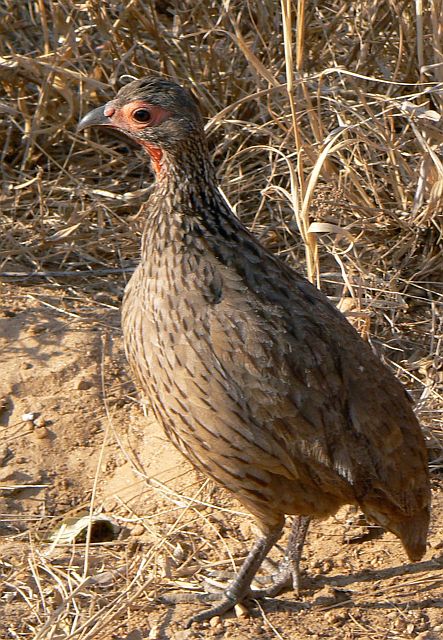 © Toko
© Toko
Female. Kruger National Park
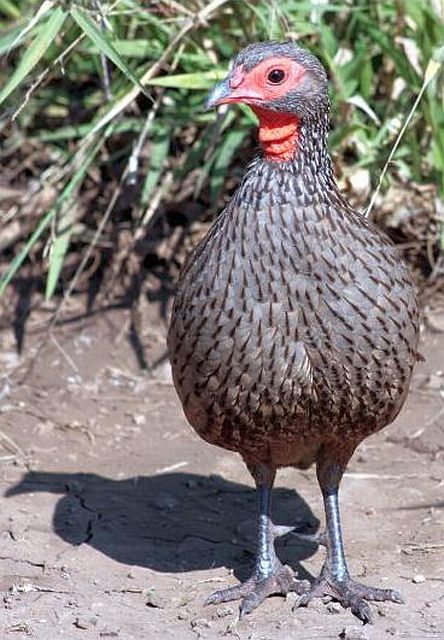 © harrys
© harrys
Male
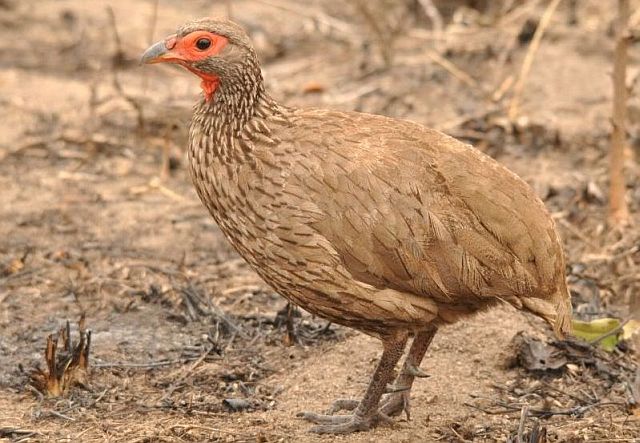 © lowveldboy
© lowveldboy
Male
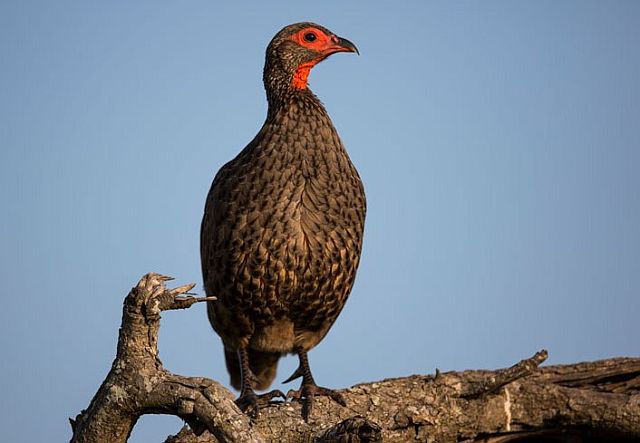 © Pumbaa
© Pumbaa
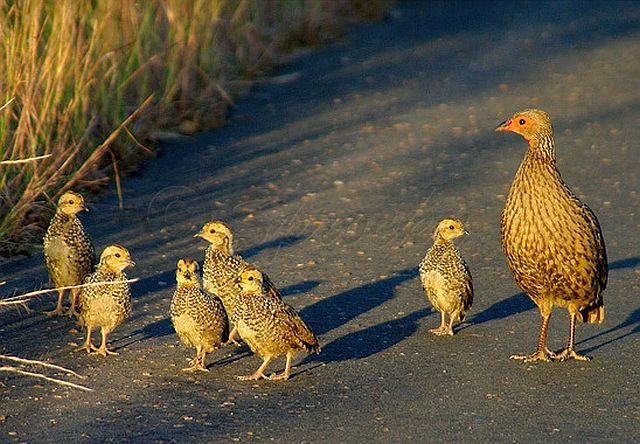 © Sprocky
© Sprocky
Links:
Species text Sabap1
Sabap2
 © Toko
© TokoFemale. Kruger National Park
 © harrys
© harrysMale
 © lowveldboy
© lowveldboyMale
 © Pumbaa
© Pumbaa © Sprocky
© SprockyLinks:
Species text Sabap1
Sabap2
- nan
- Posts: 26476
- Joined: Thu May 31, 2012 9:41 pm
- Country: Switzerland
- Location: Central Europe
- Contact:
Common Quail
200. Common Quail Coturnix coturnix (Afrikaanse Kwartel)
Order: Galliformes. Family: Phasianidae
Description
Size 17-20 cm. A small, dumpy gamebird usually flushed into flight on rapidly whirring wings. On the ground it runs swiftly, rodent-like, though the grass with its head hunched into its body.
Male has a black or russet throat and lacks the chesnut and black underparts compared with the white throat of Harlequin quail (201.) and the female Blue quail, and the black-and-white patterned throat of the male Blue quail.
Female lacks the black throat. The longitudinally streaked underparts of the female distinguish it from the barred underparts of female Blue quail.
Immature Common and Harlequin quail are evidently difficult to distinguish.
Distribution
A broad distribution over Eurasia, India, Atlantic islands, Africa and Madagascar. The Common Quail is both a resident and a nomad, both a breeding intra-African migrant and a Palearctic visitor. The nonbreeding range of the Palearctic migrants C. c. coturnix lies mainly north of the equator. It is widespread in southern Africa but avoids the most arid areas in the west and the densely wooded areas of Zimbabwe and northern Botswana. The southern breeding populations belong to C. c. africana, while a different, resident race, erlangeri, occurs in eastern Zimbabwe, western Mozambique and northwards in East Africa.
Habitat
Grassland, fields and croplands. Movements are influenced by rainfall patterns.
Movements
The South African population has been claimed to be migratory, on its breeding grounds September–April and migrating to extreme northern Namibia, Angola, western Zambia and southern DRC in the austral winter. The race erlangeri is thought to be largely sedentary.
Diet
It mainly forages in the late afternoon and early evening, scraping the ground with its feet in search of food.
Breeding
Nest is made by the female and is a scrape in the ground, lined with grass and rootlets and hidden away in dense vegetation. Breeding season (laying dates): virtually any time of year, usually after or during good rains. Female lays 2-14 eggs, one per day, after which she incubates them for 17-20 days before they hatch. Chicks leave nest usually within a day of hatching and are cared for and fed by the female for the first four days or so, after which they feed independently. After 11 days they can start to fly, after 19-21 days they have developed full flight, and after 30 days they are full grown. The male, female and chicks stay as a family for 30-50 days altogether.
Call
A high-pitched whit wit-wit, repeated at intervals, more mellow than that of Harlequin Quail; also a crwee-crwee, given in flight.
Listen to Bird Call.
Status
Locally abundant summer visitor. The Common Quail is classified as Least Concern (LC) on the IUCN Red List.
Order: Galliformes. Family: Phasianidae
Description
Size 17-20 cm. A small, dumpy gamebird usually flushed into flight on rapidly whirring wings. On the ground it runs swiftly, rodent-like, though the grass with its head hunched into its body.
Male has a black or russet throat and lacks the chesnut and black underparts compared with the white throat of Harlequin quail (201.) and the female Blue quail, and the black-and-white patterned throat of the male Blue quail.
Female lacks the black throat. The longitudinally streaked underparts of the female distinguish it from the barred underparts of female Blue quail.
Immature Common and Harlequin quail are evidently difficult to distinguish.
Distribution
A broad distribution over Eurasia, India, Atlantic islands, Africa and Madagascar. The Common Quail is both a resident and a nomad, both a breeding intra-African migrant and a Palearctic visitor. The nonbreeding range of the Palearctic migrants C. c. coturnix lies mainly north of the equator. It is widespread in southern Africa but avoids the most arid areas in the west and the densely wooded areas of Zimbabwe and northern Botswana. The southern breeding populations belong to C. c. africana, while a different, resident race, erlangeri, occurs in eastern Zimbabwe, western Mozambique and northwards in East Africa.
Habitat
Grassland, fields and croplands. Movements are influenced by rainfall patterns.
Movements
The South African population has been claimed to be migratory, on its breeding grounds September–April and migrating to extreme northern Namibia, Angola, western Zambia and southern DRC in the austral winter. The race erlangeri is thought to be largely sedentary.
Diet
It mainly forages in the late afternoon and early evening, scraping the ground with its feet in search of food.
Breeding
Nest is made by the female and is a scrape in the ground, lined with grass and rootlets and hidden away in dense vegetation. Breeding season (laying dates): virtually any time of year, usually after or during good rains. Female lays 2-14 eggs, one per day, after which she incubates them for 17-20 days before they hatch. Chicks leave nest usually within a day of hatching and are cared for and fed by the female for the first four days or so, after which they feed independently. After 11 days they can start to fly, after 19-21 days they have developed full flight, and after 30 days they are full grown. The male, female and chicks stay as a family for 30-50 days altogether.
Call
A high-pitched whit wit-wit, repeated at intervals, more mellow than that of Harlequin Quail; also a crwee-crwee, given in flight.
Listen to Bird Call.
Status
Locally abundant summer visitor. The Common Quail is classified as Least Concern (LC) on the IUCN Red List.
-
Klipspringer
- Global Moderator
- Posts: 5858
- Joined: Sat Sep 14, 2013 12:34 pm
- Country: Germany
- Contact:
Harlequin Quail
201. Harlequin Quail Coturnix delegorguei
Order: Galliformes. Family: Phasianidae
Description
14–18 cm; 68–90 g. Small, dark quail with distinctive black and white head pattern and black-and-chestnut underparts.
Male at rest is easily distinguished from the Blue and Common quails by the chestnut and black underparts. It also differs from the similarly dark-coloured male Blue quail in having a white eyebrow stripe. Female looks similar to the female Common quail but has darker chestnut-coloured underparts without a whitish coloured belly. It differs from the female Blue quail in not having barred patterning on the underparts. Immature Harlequin and Common quail are hard to distinguish.
Distribution
Widely distributed in savanna and woodland regions in Africa; also occupying southern Arabia and Madagascar. Within southern Africa it occurs in the North-West Province, Free State, Gauteng, Limpopo, Mpumalanga, northern KwaZulu-Natal, eSwatini, northern Namibia, northern Botswana, Zimbabwe and Mozambique.
Habitat
It generally favours savanna woodland with patches of bristle grasses (Setaria) and Sorghum (Sorghum purpureosericum).
Movements
Subject to large scale movements that are influenced by rainfall. There is a pattern of movement within southern Africa with birds moving south in the rainy season to breed. Migrate at night and are often killed by flying into buildings or being killed on roads.
Diet
Mainly eats invertebrates, doing most of its foraging beneath cover, or occasionally on the edges of roads and tracks.
Breeding
Pairs breed in close proximity to one another, almost forming a colony. Nest is made by the female and consists of a scrape in the ground, sometimes lined with grass or leaves, hidden among the grass. Egg-laying season peaks after heavy rains. After laying 4-8 eggs, the female incubates them for 14-18 days before they hatch. Up to 22 eggs can be found in a nest, the result of laying by multiple females. Chicks are able to fly short distances after five days.
Call
Emphatic, rhythmic kwitkwit-kwit-kwitkwit-kwit-kwit kwit-kwit, reminiscent of Common Quail, but slightly slower, marginally higher pitched and more monotonous.
Order: Galliformes. Family: Phasianidae
Description
14–18 cm; 68–90 g. Small, dark quail with distinctive black and white head pattern and black-and-chestnut underparts.
Male at rest is easily distinguished from the Blue and Common quails by the chestnut and black underparts. It also differs from the similarly dark-coloured male Blue quail in having a white eyebrow stripe. Female looks similar to the female Common quail but has darker chestnut-coloured underparts without a whitish coloured belly. It differs from the female Blue quail in not having barred patterning on the underparts. Immature Harlequin and Common quail are hard to distinguish.
Distribution
Widely distributed in savanna and woodland regions in Africa; also occupying southern Arabia and Madagascar. Within southern Africa it occurs in the North-West Province, Free State, Gauteng, Limpopo, Mpumalanga, northern KwaZulu-Natal, eSwatini, northern Namibia, northern Botswana, Zimbabwe and Mozambique.
Habitat
It generally favours savanna woodland with patches of bristle grasses (Setaria) and Sorghum (Sorghum purpureosericum).
Movements
Subject to large scale movements that are influenced by rainfall. There is a pattern of movement within southern Africa with birds moving south in the rainy season to breed. Migrate at night and are often killed by flying into buildings or being killed on roads.
Diet
Mainly eats invertebrates, doing most of its foraging beneath cover, or occasionally on the edges of roads and tracks.
Breeding
Pairs breed in close proximity to one another, almost forming a colony. Nest is made by the female and consists of a scrape in the ground, sometimes lined with grass or leaves, hidden among the grass. Egg-laying season peaks after heavy rains. After laying 4-8 eggs, the female incubates them for 14-18 days before they hatch. Up to 22 eggs can be found in a nest, the result of laying by multiple females. Chicks are able to fly short distances after five days.
Call
Emphatic, rhythmic kwitkwit-kwit-kwitkwit-kwit-kwit kwit-kwit, reminiscent of Common Quail, but slightly slower, marginally higher pitched and more monotonous.
-
Klipspringer
- Global Moderator
- Posts: 5858
- Joined: Sat Sep 14, 2013 12:34 pm
- Country: Germany
- Contact:
- Flutterby
- Posts: 44029
- Joined: Sat May 19, 2012 12:28 pm
- Country: South Africa
- Location: Gauteng, South Africa
- Contact:
Indian Peafowl
924. Indian Peafowl Pavo cristatus (Pou)
Order: Galliformes. Family: Phasianidae
Description
The male peafowl is predominantly blue with a fan-like crest of spatula-tipped wire-like feathers and is best known for the long train made up of elongated upper-tail covert feathers which bear colourful eyespots. These stiff and elongated feathers are raised into a fan and quivered in a display during courtship.
The female lacks the train, has a greenish lower neck and a duller brown plumage.
Distribution
Indigenous to Pakistan, India and Sri Lanka. Introduced to South Africa in 1968 and there are now naturalised populations on Robben Island, Cape Peninsula, Port Elizabeth and East London.
Diet
Ominivorous, diet includes seeds, leaves, fruit, invertebrates (insects, worms, centipedes, etc). Also known to eat lizards, small snakes and small mammals.
Breeding
Male has a harem of 2-5 females. He fans out his impressive tail in an elaborate courtship with a female. The nest consists of a shallow scrape in the ground lined with leaves and sticks and hidden away in thick vegetation. Also known to nest in buildings, hollows, and in large trees. The female lays 3-12 eggs (usually 3-6) at two day intervals and starts incubating them after the fifth or sixth egg has been laid. She incubates them for 28-30 days.
Chicks are active with 2 hours of hatching. The female teaches them to feed by pointing with her beak to food items. The young birds stay with the female for 5-6 months.
Order: Galliformes. Family: Phasianidae
Description
The male peafowl is predominantly blue with a fan-like crest of spatula-tipped wire-like feathers and is best known for the long train made up of elongated upper-tail covert feathers which bear colourful eyespots. These stiff and elongated feathers are raised into a fan and quivered in a display during courtship.
The female lacks the train, has a greenish lower neck and a duller brown plumage.
Distribution
Indigenous to Pakistan, India and Sri Lanka. Introduced to South Africa in 1968 and there are now naturalised populations on Robben Island, Cape Peninsula, Port Elizabeth and East London.
Diet
Ominivorous, diet includes seeds, leaves, fruit, invertebrates (insects, worms, centipedes, etc). Also known to eat lizards, small snakes and small mammals.
Breeding
Male has a harem of 2-5 females. He fans out his impressive tail in an elaborate courtship with a female. The nest consists of a shallow scrape in the ground lined with leaves and sticks and hidden away in thick vegetation. Also known to nest in buildings, hollows, and in large trees. The female lays 3-12 eggs (usually 3-6) at two day intervals and starts incubating them after the fifth or sixth egg has been laid. She incubates them for 28-30 days.
Chicks are active with 2 hours of hatching. The female teaches them to feed by pointing with her beak to food items. The young birds stay with the female for 5-6 months.
- Flutterby
- Posts: 44029
- Joined: Sat May 19, 2012 12:28 pm
- Country: South Africa
- Location: Gauteng, South Africa
- Contact:
Indian Peafowl Photos
924. Indian Peafowl Pavo cristatus
 © Flutterby
© Flutterby
Male
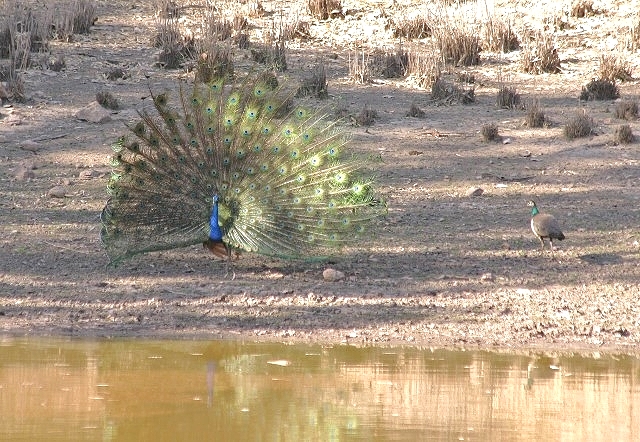 © nan
© nan
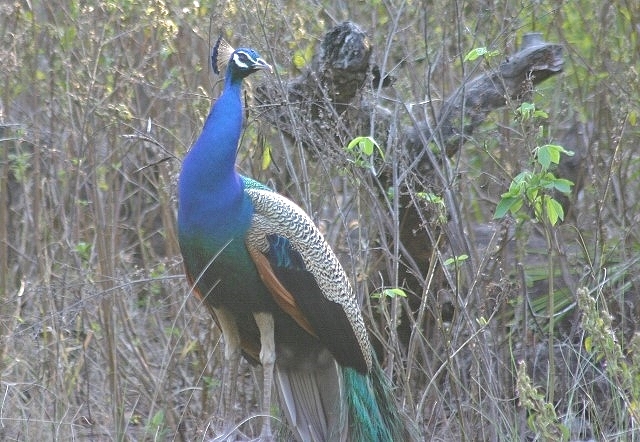 © nan
© nan
India. Male
 © Amoli
© Amoli
Female with chicks
Links:
Oiseaux net
 © Flutterby
© FlutterbyMale
 © nan
© nan © nan
© nanIndia. Male
 © Amoli
© AmoliFemale with chicks
Links:
Oiseaux net
ORDER SPHENISCIFORMES
ORDER SPHENISCIFORMES
Sphenisciformes comprises one family (Spheniscidae), six genera, and 17 species.
Penguins are restricted to the Southern Hemisphere where they are oceanic or coastal denizens.
Penguins of the Antarctic and Sub Antarctic are oceanic and breed on coasts and pack ice. Species nearer the equator may be oceanic or inhabit inshore waters and breed in coastal or forest habitats.
Penguins are notable for their upright posture and stiff wings that cannot be folded against the body. Penguins are medium to large birds (1-40 kg; 40-115 cm) with a thick layer of fat beneath the skin. Adult plumage is blue-black or gray dorsally and white ventrally, sometimes with distinctive coloring or plumes on the head. Chicks are either entirely brown-gray, or white ventrally. Juveniles have adult-like plumage. Sexes are similar. Feathers are small and continuous (no feather tracts). Bills are long and often laterally compressed, holorhinal (nostril entire), impervious nares, and schizognathous palate. Penguins are flightless divers with poorly pneumatized skeleton, carinate sternum with two lateral notches, 15 cervical vertebrae and basipterygoid processes absent. Wings are modified as flippers (wing skeleton flattened and partially fused), base of wing has vascular rete (blood vessel configuration in which cooler blood returning to the body absorbs heat from blood flowing out to the wing), pectoral muscles are large, but biceps bracii absent (unique to penguins). Legs are short; placed far posterior on body; flat tarsometatarsus is incompletely fused; palmate feet with four forward pointing toes. Bilobed oil gland is tufted.
Penguins dive well and use their flippers to swim underwater in pursuit of prey items. Prey items include anchovies, pilchards, cuttlefish, squid, and krill.
Hatching may be synchronous or asynchronous (one or two days apart). Often the younger of two chicks will not survive. Chicks are altricial and take 10-52 weeks to fledge. In some species chicks remain with and are regularly fed by adults until fledged. In other species the chicks may be fed till nearly adult size, then fast for several months while huddling with other chicks for warmth in a nursery. Average age of first reproduction differs between species, ranging from two to five years old. Life expectancy from fledging may be 20 years. Chicks have two nestling downs.
Penguins are considered monogamous and individuals often nest at the same nest site, with the same partner from the previous year. In some species, 13 year pairings have been observed. Courtship displays are varied and complex, and may include loud raucous vocalizations, 'mutual ecstatic displays'(mate recognition behaviors), and beak slapping (or bill-fencing displays).
Most penguins breed in large colonies, one of the largest being the Macaroni penguin colony in South Georgia, which is estimated to be five million pairs. Antarctic, sub-Arctic and cold temperate penguins breed in either spring or summer, whereas species in warmer climes have more continuous breeding seasons. Penguin nests range from shallow dishes of pebbles and vegetation, to holes dug in soft soil, to rocky depressions, to the space between the top of the feet and the pouch-like fold of abdominal skin. Nesting areas are diverse and include small caves, burrows, coastal forests, and pack ice. Females lay one to two whitish eggs per clutch, with two to four days between egg laying.
Overall, penguin males and females share the parental care duties, but incubation, brooding, and feeding-fasting cycles are diverse and complex. Some species begin fasting at the onset of the breeding season. In some species males and females share incubation, whereas in others incubation is primarily uniparental. Incubation duration ranges from 30-64 days, whereas parental incubation shifts may range from 5-64 days. Usually the male takes the first incubation shift after the female has laid the clutch. One of the longest incubation and fasting shifts occurs in the Emperor penguin. During the Antarctic winter, the female Emperor penguin lays one egg then departs to feed at sea. The male fasts while incubating for 60 days till the female returns at hatching time. At that point the female begins brood care while the male goes to feed at sea. Contrastingly, during the Antarctic summer the female Chinstrap penguin lays two eggs. The female then fasts while incubating for 30 days until the male returns from feeding at sea.
Some penguins waddle along shorelines and ice, whereas others hop from rock to rock. When on ice or snow, penguins can move swiftly by tobogganing (sliding along propelled by wings and feet). Penguins also use their modified wings as flippers to swim underwater. The Emperor penguin is an exceptional diver and can stay submerged for 18 minutes and dive as deep as 500 meters. Swimming speeds average two to three knots, but may reach 15-20 knots for short distances. Swimming often includes porpoising (repeatedly breaking the water's surface with enough momentum to lift the bird into the air for about one meter.)
Penguins are highly social, oftentimes breeding in large colonies. Some species forage cooperatively and may dive synchronously while foraging in small or large groups. Species that breed in large colonies often have elaborate visual and vocal displays.
Vocalizations are characterized as loud, short braying. In colonial species in which chicks group together in a nursery (or crèche) recognition of mates and offspring seems based on individually distinguishable calls.
Sphenisciformes comprises one family (Spheniscidae), six genera, and 17 species.
Penguins are restricted to the Southern Hemisphere where they are oceanic or coastal denizens.
Penguins of the Antarctic and Sub Antarctic are oceanic and breed on coasts and pack ice. Species nearer the equator may be oceanic or inhabit inshore waters and breed in coastal or forest habitats.
Penguins are notable for their upright posture and stiff wings that cannot be folded against the body. Penguins are medium to large birds (1-40 kg; 40-115 cm) with a thick layer of fat beneath the skin. Adult plumage is blue-black or gray dorsally and white ventrally, sometimes with distinctive coloring or plumes on the head. Chicks are either entirely brown-gray, or white ventrally. Juveniles have adult-like plumage. Sexes are similar. Feathers are small and continuous (no feather tracts). Bills are long and often laterally compressed, holorhinal (nostril entire), impervious nares, and schizognathous palate. Penguins are flightless divers with poorly pneumatized skeleton, carinate sternum with two lateral notches, 15 cervical vertebrae and basipterygoid processes absent. Wings are modified as flippers (wing skeleton flattened and partially fused), base of wing has vascular rete (blood vessel configuration in which cooler blood returning to the body absorbs heat from blood flowing out to the wing), pectoral muscles are large, but biceps bracii absent (unique to penguins). Legs are short; placed far posterior on body; flat tarsometatarsus is incompletely fused; palmate feet with four forward pointing toes. Bilobed oil gland is tufted.
Penguins dive well and use their flippers to swim underwater in pursuit of prey items. Prey items include anchovies, pilchards, cuttlefish, squid, and krill.
Hatching may be synchronous or asynchronous (one or two days apart). Often the younger of two chicks will not survive. Chicks are altricial and take 10-52 weeks to fledge. In some species chicks remain with and are regularly fed by adults until fledged. In other species the chicks may be fed till nearly adult size, then fast for several months while huddling with other chicks for warmth in a nursery. Average age of first reproduction differs between species, ranging from two to five years old. Life expectancy from fledging may be 20 years. Chicks have two nestling downs.
Penguins are considered monogamous and individuals often nest at the same nest site, with the same partner from the previous year. In some species, 13 year pairings have been observed. Courtship displays are varied and complex, and may include loud raucous vocalizations, 'mutual ecstatic displays'(mate recognition behaviors), and beak slapping (or bill-fencing displays).
Most penguins breed in large colonies, one of the largest being the Macaroni penguin colony in South Georgia, which is estimated to be five million pairs. Antarctic, sub-Arctic and cold temperate penguins breed in either spring or summer, whereas species in warmer climes have more continuous breeding seasons. Penguin nests range from shallow dishes of pebbles and vegetation, to holes dug in soft soil, to rocky depressions, to the space between the top of the feet and the pouch-like fold of abdominal skin. Nesting areas are diverse and include small caves, burrows, coastal forests, and pack ice. Females lay one to two whitish eggs per clutch, with two to four days between egg laying.
Overall, penguin males and females share the parental care duties, but incubation, brooding, and feeding-fasting cycles are diverse and complex. Some species begin fasting at the onset of the breeding season. In some species males and females share incubation, whereas in others incubation is primarily uniparental. Incubation duration ranges from 30-64 days, whereas parental incubation shifts may range from 5-64 days. Usually the male takes the first incubation shift after the female has laid the clutch. One of the longest incubation and fasting shifts occurs in the Emperor penguin. During the Antarctic winter, the female Emperor penguin lays one egg then departs to feed at sea. The male fasts while incubating for 60 days till the female returns at hatching time. At that point the female begins brood care while the male goes to feed at sea. Contrastingly, during the Antarctic summer the female Chinstrap penguin lays two eggs. The female then fasts while incubating for 30 days until the male returns from feeding at sea.
Some penguins waddle along shorelines and ice, whereas others hop from rock to rock. When on ice or snow, penguins can move swiftly by tobogganing (sliding along propelled by wings and feet). Penguins also use their modified wings as flippers to swim underwater. The Emperor penguin is an exceptional diver and can stay submerged for 18 minutes and dive as deep as 500 meters. Swimming speeds average two to three knots, but may reach 15-20 knots for short distances. Swimming often includes porpoising (repeatedly breaking the water's surface with enough momentum to lift the bird into the air for about one meter.)
Penguins are highly social, oftentimes breeding in large colonies. Some species forage cooperatively and may dive synchronously while foraging in small or large groups. Species that breed in large colonies often have elaborate visual and vocal displays.
Vocalizations are characterized as loud, short braying. In colonial species in which chicks group together in a nursery (or crèche) recognition of mates and offspring seems based on individually distinguishable calls.
Family Spheniscidae (Penguins) Index
Species indigenous to southern Africa:
Family Spheniscidae (Penguins)
Aptenodytes patagonicus King Penguin 002
Pygoscelis papua Gentoo Penguin 926
Eudyptes chrysocome Southern Rockhopper Penguin 004
Eudyptes chrysolophus Macaroni Penguin 005
Spheniscus demersus African Penguin, Jackass Penguin 003
Spheniscus magellanicus Magellanic Penguin
Family Spheniscidae (Penguins)
Aptenodytes patagonicus King Penguin 002
Pygoscelis papua Gentoo Penguin 926
Eudyptes chrysocome Southern Rockhopper Penguin 004
Eudyptes chrysolophus Macaroni Penguin 005
Spheniscus demersus African Penguin, Jackass Penguin 003
Spheniscus magellanicus Magellanic Penguin




